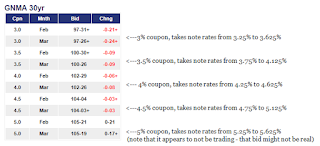| S&P Futures | 2751.5 | 4.0 |
| Eurostoxx Index | 381.0 | -1.3 |
| Oil (WTI) | 63.0 | 0.0 |
| US dollar index | 84.1 | 0.1 |
| 10 Year Govt Bond Yield | 2.89% | |
| Current Coupon Fannie Mae TBA | 102.313 | |
| Current Coupon Ginnie Mae TBA | 102.531 | |
| 30 Year Fixed Rate Mortgage | 4.4 |
Stocks are marginally higher this morning after the second revision to fourth quarter GDP came in as expected. Bonds and MBS are flat.
Fourth quarter GDP increased at 2.5%, which matched Street expectations. The price index was revised downward a touch and consumer spending was revised upward. For the year, GDP increased at 2.3% versus 1.6% for 2016. Inflation is picking up, as the price index rose 2.5% versus 1.7% in the third quarter. Excluding food and energy, the index was up 1.9%, compared to 1.3% in the third quarter.
The Chicago PMI decelerated last month, but still came in at a strong 61.9. The number was below estimates however.
Pending Home Sales fell 4.7% in January, according to NAR. This is down 3.8% YOY and the lowest since October 2014 after the Taper Tantrum. Despite higher rates and smaller inventory, traffic was up YOY in January, except for the Northeast, which could have been weather-driven.
Jerome Powell spooked the bond markets yesterday during his testimony in front of the House. He acknowledged that inflation is accelerating and that the economy has improved since the meeting in December, and that statement pushed bond yields higher. He said he didn't want to "prejudge a new set of projections," referring to the dot plot at the March meeting. Powell will testify in front of the Senate tomorrow.
The Fed Funds futures didn't really do much in response: The March futures are now handicapping an 87% chance of a hike and the consensus is still for 3 hikes this year.
Mortgage applications increased 2.7% during the holiday-shortened week, with the refi index falling 1% and the purchase index increasing 6%. The average contract rate was 4.64%, unchanged from the prior week.
The NAR and ATTOM weigh in on the real estate outlook for 2018. Unsurprisingly, they expect the inventory issue to continue, and homebuilders to modestly ramp up production while constrained by labor shortages. They point out also that the churn of move-up buyers has largely collapsed post-crisis. The average tenure (or amount of time that someone has lived in their home) has doubled since the crisis, from just over 4 years to 8 years. This lack of churn depresses the number of homes available on the market. I wonder if the churn was simply an issue related to underwater homeowners - short sales are tough to do. Second, as the foreclosure inventory is largely worked through, with the exception of the Northeast and a few other states, distressed homes are drying up. I suspect the professional investors who bought these homes will want to ring the register at some point, but that will be a function of interest rates and home price appreciation.
Lowe's missed Street estimates and is down 8% pre-open. It looks like this is a company-specific problem and doesn't reflect on the home improvement market. The Despot beat earnings recently.






